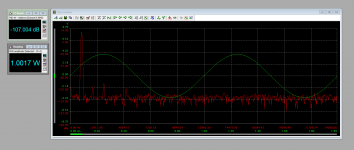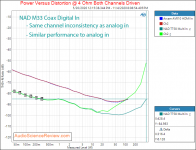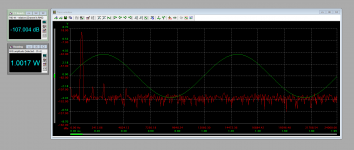You get what you pay for. At least they offer a version with the Eval 1 board Purifi made. Hard to mess that up.
Hi GeorgeCheers George
Living in my very limited experience world (*), I was surprised reading your “Class-D's Achilles heel” in post #7, that’s why I asked. But I don’t think that you have provided any convincing evidence that class D do have inherent issues with driving low Ohmic loads.
IMO that capacity is mostly to be attributed to the PSU sourcing the amplifier, rather than to the amplifier itself (assuming proper heat management).
In any case, apologies for the off-topic post.
(*) I had in my mind the recent testing of my old 41Hz Truepath amp which didn’t show any particular indication of losing steam (attached).
George
Attachments
But I don’t think that you have provided any convincing evidence that class D do have inherent issues with driving low Ohmic loads.
All you have to do is look at any Stereophile bench testing on Class-D amps and see what happens with wattage from 8ohm to 4ohm, then see "if you can find any" JA testing them into 2ohms, and "if so" getting the same increase ratio from 4 to 2ohms as they get from 8 to 4ohm.
EG: this is what they got from the low power Gryphon Essence monoblock, not a bad attempt at doubling. Find a Class-D that can mimic those increasing ratio figures into 8, 4, and 2ohm loads.
53W into 8ohms
101w into 4ohms
189w into 2ohms
Cheers George
Last edited:
Hi George
Living in my very limited experience world (*), I was surprised reading your “Class-D's Achilles heel” in post #7, that’s why I asked. But I don’t think that you have provided any convincing evidence that class D do have inherent issues with driving low Ohmic loads.
IMO that capacity is mostly to be attributed to the PSU sourcing the amplifier, rather than to the amplifier itself (assuming proper heat management).
In any case, apologies for the off-topic post.
(*) I had in my mind the recent testing of my old 41Hz Truepath amp which didn’t show any particular indication of losing steam (attached).
George
George if you make the power axis linear you should get a straight line to support your statement.
Jan
All you have to do is look at any Stereophile bench testing on Class-D amps and see what happens with wattage from 8ohm to 4ohm, then see "if you can find any" JA testing them into 2ohms, and "if so" getting the same increase ratio from 4 to 2ohms as they get from 8 to 4ohm.
EG: this is what they got from the low power Gryphon Essence monoblock, not a bad attempt at doubling. Find a Class-D that can mimic those increasing ratio figures into 8, 4, and 2ohm loads.
53W into 8ohms
101w into 4ohms
189w into 2ohms
Cheers George
Except with class D it doesn't have to keep doubling. Class D amplifiers simply have a current limit defined by the protection circuitry. Given enough voltage swing, with an appropriately set current limit, you could have a class D amplifier that would produce 1000 watts into 2 ohms, 1000 watts into 4 ohm and 1000 watts into 8 ohms. It's a 1000 watt amplifier that's current limited under all conditions because it has enough voltage swing to hit it's current limits even with a light load.
On the other hand you could power the same amplifier with a much lower voltage power supply. This one would then provide 1000 watts into 2 ohms, 500 watts into 4 ohms and 250 watts into 8 ohms.
The second amplifier is just as capable as the first when driving 2 ohms but doesn't have the voltage swing to hit it's current limits with 4 and 8 ohms.
Usually people would prefer greater power into 4 and 8 ohms so a higher voltage power supply is normally chosen.
With class AB amplifiers things are very different due to the load lines/demands placed upon the output transistors. You can easily have an amplifier that will do 250 watts into 8 ohms, 450 watts into 4 ohms, but only 100 watts into 2 ohms and maybe something like 25 watts into 1 ohm. This amplifier cannot drive 2/1 ohms loads.
With class D this simply doesn't happen. If it can drive 450 watts into 4 ohms then it will do 450 watts into 2 ohms and 450 watts into 1 ohm. Ignoring the increased losses when driving lower ohm loads. The class D amplifier becomes less efficient when driving lower ohm loads but providing adequate heatsinking it will be fine.
As you can see George you don't need the power to double for a class D amplifier to be capable of driving 2 and 1 ohm loads.
Yes and this is why they chose to tune it for 70v, rather than 85v like the Hypex NC1200. Because the NC1200 was designed for typical passive speaker loads. Where this module is designed to drive dual 4 ohm subs in parallel.
Which brings up another issue. The Hypex SMPS1200A400 only puts out +-64v. And the next up in power the SMPS1200a700 puts out +-85v. So there’s no Hypex power supply available that can output enough voltage for this new module to have more power than the 1ET400 for 95% of the speakers on the market. Because I’m unaware of any speaker with a 2 ohm nominal impedance.
Which brings up another issue. The Hypex SMPS1200A400 only puts out +-64v. And the next up in power the SMPS1200a700 puts out +-85v. So there’s no Hypex power supply available that can output enough voltage for this new module to have more power than the 1ET400 for 95% of the speakers on the market. Because I’m unaware of any speaker with a 2 ohm nominal impedance.
George if you make the power axis linear you should get a straight line to support your statement.
Jan, no statement. Just home made measurements. Easy to look up the table for 2,4,8,16 Ohm/power series, or the 3,6,12,24 Ohm/power series.
I have some more class D amps here that I will check in due course (all cheap units, not those that enter Stereophile’s Labs)
George
Weird, I thought it's the other way around, and Class D is good at driving low impedance load.
If you look at datasheet of TPA3116 or TPA325x, you can see that clean power wattage doubles as impedance halves, which allows class D amps to handle the same voltage amplitude regardless of impedance. This is not the case with A/B amps.
And I believe both of these chips can support 2 ohm loads.
If you look at datasheet of TPA3116 or TPA325x, you can see that clean power wattage doubles as impedance halves, which allows class D amps to handle the same voltage amplitude regardless of impedance. This is not the case with A/B amps.
And I believe both of these chips can support 2 ohm loads.
All class D amps can handle any load. Just some are tuned for more power at lower loads. Depending on the application they’re designed to handle. Some are tuned for more power at higher loads as well. If you want to know the true grunt of a class D module look at the amperage rating. And if you want the best match for your speakers, choose the one that has the best specs when driving the load of your speakers.
I'd like to see a pair of Wilson Alexia's which have a 0.9ohm epdr loading in much of the lower bass, being driven by whatever Class-D better, than say a Gryphon Antillion Evo can with it's manufacturers spec'd 150wrms into 8ohm 1,200wrms into 1ohm and 5,000w peak into 1/2ohm.
I've heard many a Class-D comparision on my friends system (below) and they just can't do it like the Gryphon can
SoundStageAustralia.com - Wilson Audio Specialties Alexia Series 2 Loudspeakers
Cheers George
I've heard many a Class-D comparision on my friends system (below) and they just can't do it like the Gryphon can
SoundStageAustralia.com - Wilson Audio Specialties Alexia Series 2 Loudspeakers
Cheers George
My NC500's another friends NC1200's.
And if you take the time to search his website reviews, whatever other class-d's he's reviewed. SoundStageAustralia.com - Reviews
Cheers George
And if you take the time to search his website reviews, whatever other class-d's he's reviewed. SoundStageAustralia.com - Reviews
Cheers George
The NC1200’s are 11 year old technology now. Try a proper Purifi amp build. This is how a proper Purifi 1ET400A amp measures at 1w/1khz with a proper input buffer in the signal path. In fact this is also with the DAC and Preamp stage in the signal path as well.
Attachments
All class D amps can handle any load.
Nonsense
5th Element is right.
Stein
Nonsense
5th Element is right.
Stein
I agree with him as well. Nothing he had to say was in conflict with this. The current limiter dictates when the amp module has reached its maximum current capability. Not the speaker impedance.
NAD shouldn’t be used as a reference point for Purifi either. Their M33 streaming amp only has a THD+N @ 1w/1khz of -85dB though the digital inputs! Waste of the amp modules. I’ve beat them by 22dB with my build.
Attachments
Except with class D it doesn't have to keep doubling. Class D amplifiers simply have a current limit defined by the protection circuitry. Given enough voltage swing, with an appropriately set current limit, you could have a class D amplifier that would produce 1000 watts into 2 ohms, 1000 watts into 4 ohm and 1000 watts into 8 ohms. It's a 1000 watt amplifier that's current limited under all conditions because it has enough voltage swing to hit it's current limits even with a light load.
On the other hand you could power the same amplifier with a much lower voltage power supply. This one would then provide 1000 watts into 2 ohms, 500 watts into 4 ohms and 250 watts into 8 ohms.
The second amplifier is just as capable as the first when driving 2 ohms but doesn't have the voltage swing to hit it's current limits with 4 and 8 ohms.
Usually people would prefer greater power into 4 and 8 ohms so a higher voltage power supply is normally chosen.
With class AB amplifiers things are very different due to the load lines/demands placed upon the output transistors. You can easily have an amplifier that will do 250 watts into 8 ohms, 450 watts into 4 ohms, but only 100 watts into 2 ohms and maybe something like 25 watts into 1 ohm. This amplifier cannot drive 2/1 ohms loads.
With class D this simply doesn't happen. If it can drive 450 watts into 4 ohms then it will do 450 watts into 2 ohms and 450 watts into 1 ohm. Ignoring the increased losses when driving lower ohm loads. The class D amplifier becomes less efficient when driving lower ohm loads but providing adequate heatsinking it will be fine.
As you can see George you don't need the power to double for a class D amplifier to be capable of driving 2 and 1 ohm loads.
Finally someone who Gets It.

Jan
Finally someone who Gets It.
Well Jan, someone forgot to tell the Alexia's that, because all the Class-D's tried sound weak and anemic in the bass compared to the control and heft of that the Gryphon Antillion Evo has.
Cheers George
- Home
- Amplifiers
- Class D
- Bruno strikes again



